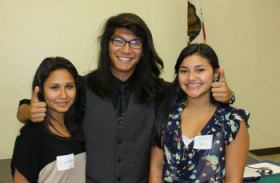You are here
Diving into a Toxic Hotspot

This post was written by Liberty Hill Foundation contributing writer Mark Bizzell and opens with an introduction by Michele Prichard, Director of Liberty Hill's Common Agenda Campaigns:
"I am happy to share with my HEFN colleagues a recent Liberty Hill blog about one of our grantees, Pacoima Beautiful, and their incredible work to educate young people about environmental health in their low-income, immigrant community of northeast Los Angeles. It is just this kind of grassroots, on-the-ground, popular education and community organizing that is helping to build momentum for the Clean UP Green UP campaign in the City of Angels—which recently passed a major hurdle in June with a 12-0 vote of the City Council to move ahead with the next steps to establish Green Zones in 3 EJ communities—including Pacoima. It is so inspiring to see how quickly these young people understand these issues—and their willingness to take action. The beat goes on!"
On a hot June day in a neighborhood in the far reaches of the San Fernando Valley, a classroom of attentive high-school age students listens as instructor Imelda Padilla asks why “equal access” is important to citizens seeking environmental justice.
“Environmental Impact Reports are only in English,” says one student.
“The reports are hard to read,” says another.
“And is that equal access?” Padilla asks
“No!” the class responds in unison.
This is not summer session at a high school Earth Science class. These bright young students are voluntarily dedicating their break to the four-week Summer Institute offered by Pacoima Beautiful, a 16 year-old community-based organization that is one of the anchor organizations behind the innovative “Clean Up Green Up” environmental justice campaign that Liberty Hill has long supported.
The Summer Institute has enrolled 37 students this year from Pacoima and surrounding communities to learn through classroom studies, field trips and hands-on activities about social and environmental justice issues and also the nuts-and-bolts of environmental science. Debunking the unfounded stereotype that exists of students from low-income and working class families of color, these are intelligent, civic-minded teenagers who are motivated to better their community and environment.
As the discussion continues, Padilla explains to the class that planning meetings are held far away in downtown Los Angeles, when students are in school and parents are at work, further denying Pacoima residents equal access to the decision-making process about their neighborhood.
Jasmine Gavay is just 15 years old and after just a few weeks in the program is inspired to volunteer. “I recycle more than just plastic and cans now, and know to call 311 to request that large items, like sofas or TVs, be removed from the street,” says Jasmine.
“I plan on becoming a community organizer,” adds Vianey Mancillas, who at age 16 has already been involved with Pacoima Beautiful for two years. “The Summer Institute teaches us how City Hall works.”
Pacoima is in an area of Los Angeles bisected by train tracks and dotted with auto-body repair and metal-plating shops. Home to a large working-class Latino population, the community has lots of civic pride and concern for the health and safety of its neighbors, fueling involvement in Pacoima Beautiful. The organization, founded in 1996 with grassroots and community-based support, most recently scored a victory when the L.A. City Council approved the next phase of the “Clean Up Green Up” proposal to improve some of the most polluted neighborhoods in the city. The proposal recommends designating Pacoima as one of three “green zones” where the City Planning Department will draft guidelines to reduce and prevent pollution in “hot spot” communities.
The Summer Institute, one of the many youth programs that Pacoima Beautiful offers, meets four hours each weekday of the session to cover such subjects as the history of Cesar Chavez, the workings of the EPA, and how to navigate city government. The students also travel to blighted areas of their communities to see firsthand the causes of some of the problems. Steve Santana says he has learned from the classes that the San Fernando Valley has some of the highest asthma rates in the nation. He wants to educate and recruit others to make a difference in their community.
“We also help the students think about college and prepare them to apply,” Padilla says. Along with instructors Osbaldo Robles, Yvette Lopez and Sandra Ramirez, she is impressed by their discipline and concern for the environment and the community.
Students are recruited to attend the Summer Institute from high schools in the region, which include the communities of Arleta, Sun Valley and the city of San Fernando, and others in addition to Pacoima. Because most of the area is within the city of Los Angeles, community involvement is important in order to be heard by the powers in City Hall, almost 15 miles away.
At the July 3 graduation ceremony, the students are dressed to impress and a bit nervous about giving presentations on what they have learned. The room is packed with dignitaries and representatives from allied organizations, including Heal the Bay, Tree People, Natural Resources Defense Council (NRDC), Liberty Hill Foundation, and others.
Marcos Sanchez, field representative for Pacoima native Representative Raul Bocanegra of the 39th Assembly District, is on hand to bestow diplomas on the graduates. Before that happens, the students give presentations on recycling, pollution sources, and the importance of voting. The audience is educated on how the area has 14 landfills that were a part of the students’ “toxic tours.”
Vianey may be only 16, but she is learning skills and gaining knowledge that will help her to become a leader of tomorrow. She and the other students all say they are inspired and motivated to make a difference in their community.
“I realize I first need to become educated in order to become an effective community organizer. The Summer Institute is helping me achieve my goal,” says Vianey.
This post was authored by Liberty Hill Foundation volunteer contributing writer Mark Bizzell. It originally ran on Liberty Hill's blog, News from the Frontline, on July 19, 2013 and is reprinted with permission.
From our Blog
Upcoming Events
|
Jul 16 2024 Zoom |
Jul 18 2024 Zoom |

